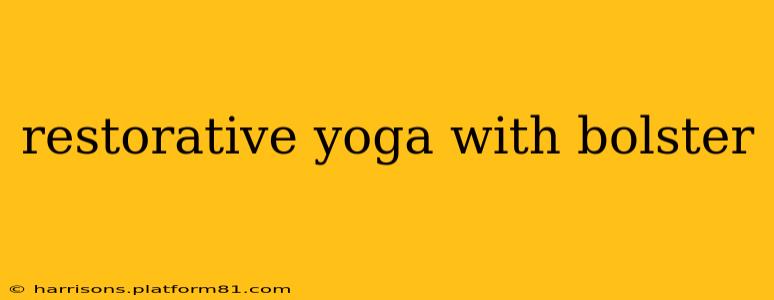Restorative yoga, a gentle and passive practice, uses props like bolsters, blankets, and blocks to support the body in comfortable poses. This allows for deep relaxation, stress reduction, and a profound sense of rejuvenation. Bolsters, in particular, are invaluable tools in restorative yoga, providing crucial support for the spine, hips, and chest, enabling you to fully surrender into each pose and experience its restorative benefits. This article explores the many ways bolsters enhance restorative yoga practice and answers common questions about their use.
What is Restorative Yoga?
Restorative yoga differs significantly from other styles. It's not about challenging your physical strength or achieving complex postures. Instead, it focuses on holding passively supported poses for extended periods (typically 3-5 minutes, sometimes longer), allowing your body and mind to completely unwind. The emphasis is on deep relaxation, stress reduction, and promoting a sense of inner peace. By removing physical effort, you create space for the parasympathetic nervous system to take over, initiating the body's natural healing and restorative processes.
How Does a Bolster Enhance Restorative Yoga?
Bolsters provide essential support, allowing your body to sink deeply into the pose without strain. This support is crucial for:
- Spinal Alignment: Bolsters gently support the natural curves of your spine, alleviating tension and promoting proper alignment. This is particularly beneficial for those with back pain or stiffness.
- Hip Opening: Bolsters can be strategically placed to support the hips and gently encourage deeper opening, releasing tension in the lower back and pelvis.
- Chest Expansion: Positioning a bolster under the chest can create space for easier breathing, reducing feelings of tightness and promoting a sense of openness.
- Relaxation: The physical comfort provided by the bolster allows your body to completely relax, leading to a deeper state of mental and emotional relaxation.
What are the Benefits of Restorative Yoga with a Bolster?
The combined benefits of restorative yoga and the use of a bolster are numerous:
- Stress Reduction: Restorative yoga's passive nature and the bolster's support are highly effective in reducing stress hormones and promoting relaxation.
- Improved Sleep: The deep relaxation achieved through this practice can significantly improve sleep quality.
- Pain Relief: The gentle support offered by the bolster can alleviate pain associated with backaches, hip tightness, and other common ailments.
- Increased Energy: Paradoxically, this deeply restful practice can leave you feeling more energized and refreshed.
- Emotional Regulation: The quiet introspection fostered by restorative yoga can promote emotional balance and resilience.
What Types of Bolsters are Best for Restorative Yoga?
Several bolster types are available:
- Round Bolsters: These are versatile and well-suited for many restorative poses.
- Rectangular Bolsters: Offer a broader support surface, ideal for poses requiring more stability.
- Filling Material: Look for bolsters filled with materials like buckwheat hulls (offer good support and adjust to your body) or kapok (softer and more conforming).
What are Some Restorative Poses that Utilize a Bolster?
Many poses benefit significantly from a bolster. Here are a few examples:
- Supported Child's Pose: Place the bolster lengthwise under your abdomen and chest for extra support.
- Supported Reclined Butterfly Pose: Place the bolster under your hips and back for a deeper release in the hips and groin.
- Supported Supta Matsyendrasana (Supine Spinal Twist): Use the bolster to support your spine and legs during this gentle twist.
- Supported Bridge Pose: Place a bolster under your sacrum for added support and backbend depth.
Where Can I Find Restorative Yoga Classes?
Many yoga studios and gyms offer restorative yoga classes. You can also find online videos and resources that guide you through restorative sequences. Look for instructors who are experienced in teaching restorative yoga and emphasize the use of props.
Is Restorative Yoga Suitable for Everyone?
While generally safe, it's advisable to consult your doctor or physical therapist before starting any new yoga practice, especially if you have pre-existing medical conditions. Restorative yoga is often modified to suit individual needs and limitations.
Can I Practice Restorative Yoga at Home?
Absolutely! With a bolster and some basic yoga props, you can easily practice restorative yoga at home. Many online resources provide guided sessions and instructions for setting up your home practice.
By incorporating a bolster into your restorative yoga practice, you enhance the experience, allowing for a deeper release of tension and a profound sense of relaxation. This passive, yet powerful, form of yoga offers significant benefits for both physical and mental well-being. Remember to listen to your body and adjust poses as needed for optimal comfort and support.
